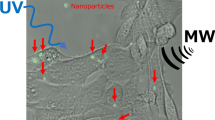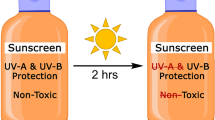Abstract
The photostability of the widely used UVB sunscreen agents 2′-ethylhexyl-2-cyano-3-phenylcinnamate (1), 2-hydroxy-4-methoxybenzophenone (2), octyl salicilate (3), and 2′-ethylhexyl-4-methoxycinnamate (4) has been investigated under UVA irradiation in the absence and presence of TiO2, an inorganic filter commonly employed in combination with organic filters in sunscreen preparations. In the absence of TiO2, 1-3 are photostable and 4 undergoes the expected E-Z isomerization; the presence of TiO2 caused mineralization of the organic filters and, surprisingly, the process is noticeably faster in the presence of surfactant than in sunscreen and water suspensions. The results indicate that in water suspension, mineralization is likely to occur on or near the TiO2 particle surface; when the organic sunscreens are segregated in the micelle core, reactive radicals, produced during TiO2-promoted degradation of the micellar system, may participate in sunscreen degradation. In addition, a pre-fluorescent probe for carbon-centered radical detection, 4-(3-hydroxy-2-methyl-4-quinolineoxy)-2,2,6,6,-tetramethylpiperidine-1-oxyl free radical or QT (5), was employed to demonstrate that carbon-centered radicals are evolved during micelle degradation and may participate in the mineralization of sunscreens.
Similar content being viewed by others
References
J. Knowland, E. A. McKenzie, P. J. McHugh and N. A. Cridland, Sunlight mutagenicity of a common sunscreen ingredient FEBS Lett. 1993 324 309–313
M. Gulston and J. Knowland, Illumination of human keratinocytes in the presence of the sunscreen ingredient padimate-O and through an SPF-15 sunscreen reduces direct photodamage to DNA but increases strand breaks Mutat. Res. 1999 444 49–60
F. Gasparro, UV induced photoproducts of p-aminobenzoic acid Photodermatology 19852151–157
A. A. Shaw, L. A. Wainschel and M. D. Shetlar, The photochemistry of p-aminobenzoic acid Photochem. Photobiol. 1992 55 647–656
C. F. Chignell, B. Kalyanaraman, R. P. Mason and R. H. Sik, Spectroscopic studies of cutaneous photosensitizing agents. I. Spin trapping of photolysis products from sulfanilamide, 4-aminobenzoic acid, and related compounds Photochem. Photobiol. 1980 32 565–571
N. A. Shaath, K. Klein and D. Steinberg, Encyclopedia of UV absorbers for sunscreen products, in Sun Products: Protection and Tanning, Allured Publishing Corp., Carol Stream, IL, 1998, pp. 30-61
J. M. Allen, S. K. Allen and B. Lingg, Photostabilities of several chemical compounds used as active ingredients in sunscreens Spec. Publ.-R. Soc. Chem. 1998 225 171–181
P. Morliere, O. Avice, T. Sa e Melo, L. Dubertret, M. Giraud and R. Santus, A study of the photochemical properties of some cinnamate sunscreens by steady state and laser flash photolysis Photochem. Photobiol. 1982 36 395–399
G. J. Smith and I. J. Miller, The effect of molecular environment on the photochemistry of p-methoxycinnamic acid and its esters J. Photochem. Photobiol., A 1998 118 93–97
J. K. Broadbent, B. S. Martincigh, M. W. Raynor, L. F. Salter, R. Moulder, P. Sjoberg and K. E. Markides, Capillary supercritical fluid chromatography combined with atmospheric pressure chemical ionization mass spectrometry for the investigation of photoproduct formation in the sunscreen absorber 2-ethylhexyl-p-methoxycinnamate J. Chromatogr., A 1996 732 101–110
D. Decuyper-Debergh, J. Piette, C. Laurent and A. van de Vorst Cytotoxic and genotoxic effects of extracellular generated singlet oxygen in human lymphocytes in vitro Mutat. Res. 1989 22 11–14
J. Allen and C. Gossett, Photochemical formation of singlet molecular oxygen in illuminated aqueous solution of several commercialy available sunscreen active ingredients Chem. Res. Toxicol. 19969605–609
A. Fujishima, T. N. Rao and A. Tryk, Titanium dioxide photocatalysis J. Photochem. Photobiol., C 200011–21
D. E. Ollis and H. Al-Ekabi, Photocatalytic Purification and Treatment of Water and Air, Elsevier, Amsterdam, 1993
A. Fujishima, K. Hashimoto and T. Watanabe, TiO2 Photocatalysis, Fundamentals and Applications, BKC Inc., Tokyo, 1999
M. Turkoglu and S. Yener, Design and in vivo evaluation of ultrafine inorganic-oxide-containing-sunscreen formulations Int. J. Cosmet. Sci. 1997 19 193–201
R. G. Van der Molen, H. M. H. Hurks, C. Out-Luiting, F. Spies, J. M. van’t Noordende, H. K. Koerten and A. M. Mommaas, Efficacy of micronized titanium dioxide compounds in protection against UVB-induced immunosoppression in humans in vivo J. Photochem. Photobiol., B 1998 44 143–150
G. Meacock, K. D. A. Taylor, M. Knowles and A. Himonides, The improved whitening of minced cod flesh using dispersed titanium dioxide J. Sci. Food Agric. 1997 73 221–225
M. R. Dhananjeyan, R. Annapoorani and P. Renganathan, A comparative study on the TiO2 mediated photo-oxidation of uracil, thymine, and 6-methyluracil J. Photochem. Photobiol., A 1997 109 147–153
H. Hidaka, S. Horikoshi, K. Ajisaka, J. Zhao and N. Serpone, Fate of amino acids upon exposure to aqueous titania irradiated with UVA and UVB irradiation: photocatalyzed formation of NH3, NO3−, and CO2J. Photochem. Photobiol., A 1997 108 197–205
H. Hidaka, S. Horikoshi, N. Serpone and J. Knowland, In vitro photochemical damage to DNA, RNA, and their bases by an inorganic sunscreen agent on exposure to UVA and UVB radiation J. Photochem. Photobiol., A 1997 111 205–213
T. Hancock-Chen and J. C. Scaiano, Enzyme inactivation by TiO2 photosensitization J. Photochem. Photobiol., B 2000 57 193–196
R. Dunford, A. Salinaro, L. Cai, N. Serpone, S. Horikoshi, H. Hidaka and J. Kwnoland, Chemical oxidation and DNA damage catalysed by inorganic sunscreen ingredients FEBS Lett. 1997 418 87–90
US Food and Drug Administration (Department of Health and Human Services) Sunscreen drug products for over-the-counter human use; final monograph Fed. Regist. 1999 64 27666–27693
T. Hancock-Chen, Biologically relevant free radical reactions, PhD thesis, University of Ottawa, Canada, 2001
Formulators fine tune TiO2-based screens, Manuf. Chem., 1993, 64, 26–29
F. Kiriakidou, D. I. Kondarides and X. E. Verykios, The effect of operational parameters and TiO2-doping on the photocatalytic degradation of azo-dyes Catal. Today 1999 54 119–130
A. Aspee, O. García, L. Maretti, R. Sastre and J. C. Scaiano, Free radical reactions in poly(methyl methacrylate) films monitored using a pre-fluorescent quinoline-TEMPO sensor, Macromolecules, 2003, in press
J. Chateauneuf, J. Lusztyk and K. U. Ingold, Absolute rate constants for the reaction of some carbon centered radicals with 2,2,6,6,-tetramethyl-1-piperidinoxyl J. Org. Chem. 1998 53 1629–1632
N. V. Blough and D. J. Simpson, Chemically mediated fluorescence yield switching in nitroxide-fluorophore adducts: optical sensors of radical/redox reactions J. Am. Chem. Soc. 1988 110 1915–1917
S. A. Green, D. J. Simpson, G. Zhou and N. V. Bloug, Intramolecular quenching of excited states by stable nitroxyl radicals J. Am. Chem. Soc. 1990 112 7337–7346
G. O. Ballesteros, L. Maretti, R. Sastre and J. C. Scaiano, Kinetics of cap separation in nitroxide-regulated “living” free radical polymerization: application of a novel methodology involving a prefluorescent nitroxide switch Macromolecules 2001 36 6184–6187
G. Moad, D. A. Shipp, T. A. Smith and D. H. Solomon, Measurements of primary radical concentrations generated by pulsed laser flash photolysis using fluorescence detection J. Phys. Chem. A 1999 103 6580–6586
S. C. Ameta, P. B. Punjabi, P. Rao and B. Singhal, Use of titanium dioxide as a photocatalyst for photodegradation of sodium lauryl sulfate J. In. Chem. Soc. 2000 77 157–160
J. Lea and A. A. Adesina, The photo-oxidative degradation of sodium dodecyl sulfate in aerated aqueous TiO2 suspension J. Photochem. Photobiol., A 1998 118 111–122
J. A. Nelson, S. Chou and T. A. Spencer, Oxidative demethylation at C-4 of a steroid via nitroxide photolysis. J. Am. Chem. Soc. 1975 97 648–649
L. J. Johnston, M. Tencer and J. C. Scaiano, Evidence for hydrogen transfer in the photochemistry of 2,2,6,6-tetramethylpiperidine-N-oxyl J. Org. Chem. 1986 51 2806–2808
G. A. Epling, C. Black and V. Rawal, Photochemistry in micelles as a model for the in vivo phototoxicity of chlorpromazine J. Chem. Soc., Perkin Trans. 2 198391313–1316
S. Sortino, G. De Guidi and S. Giuffrida, Drastic photochemical stabilization of lomefloxacin through selective and efficient self-incorporation of its cationic form in anionic sodium dodecyl sulfate (SDS) micelles New J. Chem. 2001 25 197–199
S. Sortino, L. J. Martinez and G. Marconi, On the photophysical and photochemical behavior of fenbrufen: a study in homogeneous media and micellar environments New J. Chem. 2001 25 975–980
R. Cai, Y. Kubota, T. Shuin, H. Sakai, K. Hashimoto and A. Fusjishima, Induction of cytotoxicity by photoexctited TiO2 particles Cancer Res. 1992 52 2346–2348
Y. Kubota, T. Shuin, C. Kawasaki, M. Hosaka, H. Kitamura, R. Cai, H. Sakai, K. Hashimoto and A. Fujishima, Photokilling of T-24 human bladder cancer cells with titanium dioxide Br. J. Cancer 1994 70 1107–1111
Author information
Authors and Affiliations
Corresponding author
Additional information
Dedicated to the memory of Nobel Laureate, Lord George Porter FRSC FRS OM.
Rights and permissions
About this article
Cite this article
Ricci, A., Chrétien, M.N., Maretti, L. et al. TiO2-promoted mineralization of organic sunscreens in water suspension and sodium dodecyl sulfate micelles. Photochem Photobiol Sci 2, 487–492 (2003). https://doi.org/10.1039/b212815b
Received:
Accepted:
Published:
Issue Date:
DOI: https://doi.org/10.1039/b212815b




